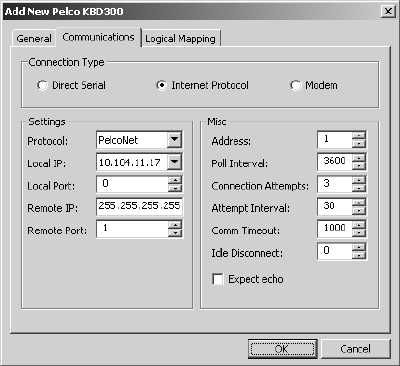
88 C1553M-B (4/05)
Internet Protocol Settings
Figure 100. Communications Tab for KBD300 Internet Settings
a. Protocol: If the keyboard is connected to a PelcoNet device, follow the instructions in step (1). If the keyboard is connected to some
other kind of device, follow the instructions in step (2).
(1) Select the PelcoNet protocol from the Protocol drop-down list. If the PelcoNet device has a user name and password defined in
the internal device settings, you will be prompted to enter the user name and password before proceeding.
Then complete the following fields as described below:
Local IP: The local IP is the IP address of the computer that the Pelco KBD300 device driver runs on. Select the local IP from the
drop-down box.
Local Port: The local port is the port the Pelco KBD300 device driver uses to transmit commands. If your system is secured
behind a firewall, enter one of the ports made available by the firewall. Otherwise, enter 0 to have the driver randomly assign an
available port. Tip: To find out what port the driver assigned, switch or control the device in the VMX300(-E) client, and then use
the netstat command at the DOS prompt to view assigned ports.
Remote IP: Enter the IP address of the PelcoNet device in the Remote IP box.
Remote Port: In the Remote Port box, select the port on the PelcoNet device that the keyboard is connected to. Select 1 if the
keyboard is connected to COM 1 on the PelcoNet device. Select 2 if the keyboard is connected to COM 2.
(2) Other: Select the desired transport protocol from the Protocol drop-down box.
Then complete the following fields as described below:
Local IP: The local IP is the IP address of the VMX300(-E) workstation that the Pelco KBD300 driver runs on. Select the local IP
from the drop-down list.
Local Port: The local port is the port the Pelco KBD300 driver uses to transmit commands. If your system is secured behind a fire-
wall, enter one of the ports made available by the firewall. Otherwise, enter 0 to have the driver randomly assign an available
port. Tip: To find out what port was randomly assigned in a particular instance, switch or control the device in the VMX300(-E)
client, then use the netstat command at the DOS prompt to view assigned ports.
Remote IP: The remote device is the device the keyboard is physically connected to. The remote IP is the IP address of the
VMX300(-E) workstation the remote device’s driver runs on. Enter the remote IP in the Remote IP box.
Remote Port: In the Remote Port box, enter the port the remote device’s driver uses to receive commands.
b. Refer to Step 3 for instructions on completing the fields in the Miscellaneous section.
3. Misc: Configure the following fields in the Misc section of the Communications tab:


















